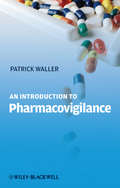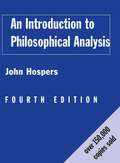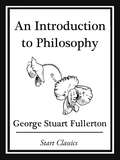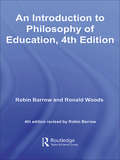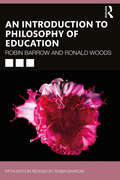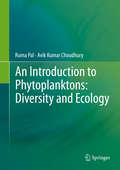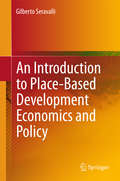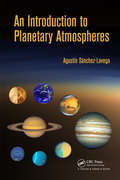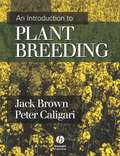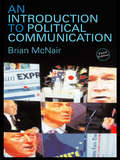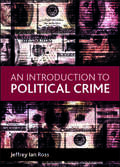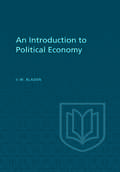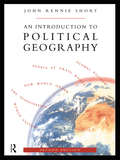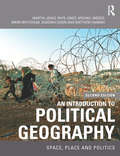- Table View
- List View
An Introduction to Petroleum Technology, Economics, and Politics
by James G. SpeightThe perfect primer for both the layperson and the engineer, for the new hire and the old hand, describing, in easy-to-understand language, one of the biggest and most lucrative industries in the world. There is only one substance known to mankind that can cause wars, influence global economies, and make entire countries rich: petroleum. One teaspoon of the stuff carries enough energy to power a ton truck up a hill. It's in the news every single day, it influences our lives in ways that we cannot fathom, and it is the most important commodity in the world. But how much does the average person, even the average engineer, know about it? This book describes the petroleum industry, in easy-to-understand language, for both the layperson and engineer alike. From the economics of searching for oil and gas to the pitfalls of drilling and production, getting it out of the ground, into pipelines, into refineries, and, finally, into your gas tank, this book covers the petroleum industry like no other treatment before. There is coverage of pricing and the economics of this very important resource, as well, which is useful not only to engineers, but to economists and, really, anyone who uses it. From jet fuel to gasoline to natural gas and plastics, petroleum is one of the integral products of our lives. We are practically bathed it in from birth, our food is protected by it, and it even has healing properties. Learn all about this incredible substance and its fascinating history and highly debated future. An Introduction to Petroleum Technology, Economics, and Politics: Gives a thorough summary of the petroleum and natural gas industry, from prospect to production to pipeline New technologies, such as directional and underbalanced drilling, are covered, in easy-to-understand language Useful not only for newcomers and laypersons, but for engineers and students, particularly those for whom English is a second language Examines the basics of pricing and valuation
An Introduction to Pharmacovigilance
by Patrick Waller Mira Harrison-WoolrychPharmacovigilance is the science and activities relating to the detection, assessment, understanding and prevention of adverse effects or any other drug-related problems. This introductory guide is designed to aid the rapid understanding of the key principles of pharmacovigilance. Packed full of examples illustrating drug safety issues it not only covers the processes involved, but the regulatory aspects and ethical and societal considerations of pharmacovigilance. Covering the basics step-by-step, this book is perfect for beginners and is essential reading for those new to drug safety departments and pharmaceutical medicine students. The second edition is thoroughly revised and updated throughout and includes a new chapter on clinical aspects of pharmacovigilance.
An Introduction to Pharmacovigilance
by Patrick WallerPharmacovigilance is the science and activities relating to the detection, assessment, understanding and prevention of adverse effects or any other drug-related problems. This introductory guide is designed to aid the rapid understanding of the key principles of pharmacovigilance. Packed full of examples illustrating drug safety issues it not only covers the processes involved, but the regulatory aspects and ethical and societal considerations of pharmacovigilance. Covering the basics step-by-step, this book is perfect for beginners and is essential reading for those new to drug safety departments and pharmaceutical medicine students.
An Introduction to Phase-Integral Methods (Dover Books on Mathematics)
by John HeadingThe phase-integral method in mathematics, also known as the Wentzel-Kramers-Brillouin (WKB) method, is the focus of this introductory treatment. Author John Heading successfully steers a course between simplistic and rigorous approaches to provide a concise overview for advanced undergraduates and graduate students in mathematics and physics. Since the number of applications is vast, the text considers only a brief selection of topics and emphasizes the method itself rather than detailed applications. The process, once derived, is shown to be one of essential simplicity that involves merely the application of certain well-defined rules. Starting with a historical survey of the problem and its solutions, subjects include the Stokes phenomenon, one and two transition points, and applications to physical problems. An appendix and bibliography conclude the text.
An Introduction to Philosophical Analysis
by John HospersJohn Hospers' Introduction to Philosophical Analysis has sold over 150,000 copies since its first publication. This new edition ensures that its success will continue into the twenty-first century. It remains the most accessible and authoritative introduction to philosophy available using the full power of the problem-based approach to the area to ensure that philosophy is not simply taught to students but practised by them.The most significant change to this edition is to respond to criticisms regarding the omission in the third edition of the famous opening chapter. A brand new chapter, Words and the World, replaces this in the fourth edition - which now features a large number of examples and illustrative dialogues. The rest of the text has been thoroughly revised and updated to take account of recent developments in some areas of philosophy.
An Introduction to Philosophy
by George Stuart FullertonThis anthology is a thorough introduction to classic literature for those who have not yet experienced these literary masterworks. For those who have known and loved these works in the past, this is an invitation to reunite with old friends in a fresh new format. From Shakespeare s finesse to Oscar Wilde s wit, this unique collection brings together works as diverse and influential as The Pilgrim s Progress and Othello. As an anthology that invites readers to immerse themselves in the masterpieces of the literary giants, it is must-have addition to any library
An Introduction to Philosophy of Education
by Robin Barrow Ronald WoodsThis introductory text, now in its fourth edition, is a classic in its field. It shows, first and foremost, the importance of philosophy in educational debate and as a background to any practical activity such as teaching. What is involved in the idea of educating a person or the idea of educational success? What are the criteria for establishing the optimum balance between formal and informal teaching techniques? How trustworthy is educational research? In addition to these questions, which strike to the heart of the rationale for the educative process as a whole, the authors explore such concepts as culture, creativity, autonomy, indoctrination, needs, interests and learning by discovery. In this new updated edition, the authors draw on the latest research in genetics to argue that education is uniquely human and is essentially what develops us as humans. Resisting modern tendencies to equate knowledge with opinion, and value judgements with taste, this book leads the reader into the business of philosophising and champions the cause of reason in education.
An Introduction to Philosophy of Education
by Robin Barrow Ronald WoodsThis introductory text, now in its fifth edition, is a classic in its field. It shows, first and foremost, the importance of philosophy in educational debate and as a background to any practical activity such as teaching. What is involved in the idea of educating a person or the idea of educational success? What are the criteria for establishing the optimum balance between formal and informal teaching techniques? How trustworthy is educational research? In addition to these questions, which strike to the heart of the rationale for the educative process as a whole, the authors explore such concepts as culture, creativity, autonomy, indoctrination, needs, interests, and learning by discovery. Updates to this edition include new chapters on religious education and moral education, as well as questions for reflection at the end of each chapter.
An Introduction to Philosophy: A Christian Guide to the Things that Really Matter
by Steven B. Sherman Richard A. Holland Gary S. Osmundsen Peter J. RasorDesigned for students in Christian colleges and seminaries, An Introduction to Philosophy surveys the four main areas of philosophy - logic, metaphysics, epistemology, and ethics - in an accessible and engaging manner. Yet it also covers important topics sometimes left unaddressed in introductions, including:why philosophy matters in our daycritical thinking and intellectual virtuea brief history of philosophyphilosophical hermeneuticsthe relationship between philosophy, faith, and worldviewreligious epistemologybioethics, sexual ethics, other types of ethicsa Christian philosophy of lifeGrounded in the Christian intellectual tradition, each chapter in An Introduction to Philosophy includes student-friendly features such as chapter summaries, explanatory sidebars, reflection questions, vocabulary words and definitions, and suggestions for further reading. Professors and students will find it to be a broad and useful overview, perfect for undergraduate and seminary students alike.
An Introduction to Physical Oncology: How Mechanistic Mathematical Modeling Can Improve Cancer Therapy Outcomes (Chapman & Hall/CRC Mathematical Biology Series)
by Vittorio Cristini Eugene Koay Zhihui WangPhysical oncology has the potential to revolutionize cancer research and treatment. The fundamental rationale behind this approach is that physical processes, such as transport mechanisms for drug molecules within tissue and forces exchanged by cancer cells with tissue, may play an equally important role as biological processes in influencing progression and treatment outcome. <P><P>This book introduces the emerging field of physical oncology to a general audience, with a focus on recent breakthroughs that help in the design and discovery of more effective cancer treatments. It describes how novel mathematical models of physical transport processes incorporate patient tissue and imaging data routinely produced in the clinic to predict the efficacy of many cancer treatment approaches, including chemotherapy and radiation therapy. By helping to identify which therapies would be most beneficial for an individual patient, and quantifying their effects prior to actual implementation in the clinic, physical oncology allows doctors to design treatment regimens customized to each patient’s clinical needs, significantly altering the current clinical approach to cancer treatment and improving the outcomes for patients.
An Introduction to Physical Science (13th Edition)
by James Shipman Jerry D. Wilson Aaron Todd Charles A. HigginsConsistent with previous editions of An Introduction to Physical Science, the goal of the new Thirteenth edition is to stimulate students' interest in and gain knowledge of the physical sciences. Presenting content in such a way that students develop the critical reasoning and problem-solving skills that are needed in an ever-changing technological world, the authors emphasize fundamental concepts as they progress through the five divisions of physical sciences: physics, chemistry, astronomy, meteorology, and geology. Ideal for a non-science majors course, topics are treated both descriptively and quantitatively, providing instructors the flexibility to emphasize an approach that works best for their students.
An Introduction to Phytoplanktons: Diversity And Ecology
by Ruma Pal Avik Kumar ChoudhuryThe book , 'An Introduction to Phytoplanktons - Diversity and Ecology' is very useful as it covers wide aspects of phytoplankton study including the general idea about cyanobacteria and algal kingdom. It contains different topics related to very basic idea of phytoplanktons such as, types ,taxonomic description and the key for identification etc. Together with it, very modern aspects of phytoplankton study including different methodologies needed for research students of botany, ecology, limnology and environmental biology are also included. The first chapter is very basic and informative and describes algal and phytoplankton classification, algal pigments, algal bloom and their control, algal toxins, wetlands algae, ecological significance of phytoplanktons etc. A general key for identification of common phytoplankton genera is also included for students who will be able to identify these genera based on the light microscopic characters. In Chapters 2-4, different aspects of phytoplankton research like primary productivity, community pattern analysis and their ecological parameter analysis have been discussed with detailed procedures. Statistical analysis is also discussed in detail. Chapter 5 includes case studies related to review, phytoplankton diversity and dynamics.
An Introduction to Place-Based Development Economics and Policy
by Gilberto SeravalliThis book introduces the reader to local development economics and policy, with a special focus on the place-based paradigm that covers its justification, its difficulties and the types of public intervention that it suggests. The starting point for the analysis is that economic development in lagging places is not to be expected as the result of a mechanism of automatic convergence between backward and advanced regions and that, therefore, the most appropriate development policy is not to maximize competition among all agents in all sectors and places. The failure of the Washington Consensus is examined, and the two competing positions to have emerged from this failure - spatially blind interventions and place-based policies - are contrasted. The main shortcoming of spatially blind policies, namely that immobile resources that could trigger or support a development process often remain untapped or "trapped", is emphasized. The limitations of the "big push" state intervention and wage flexibility solutions to this trap are analyzed and the merits of place-based policies that support intervention and can deal with uncertainty, risk and conflict are discussed.
An Introduction to Planetary Atmospheres
by Agustin Sanchez-LavegaPlanetary atmospheres is a relatively new, interdisciplinary subject that incorporates various areas of the physical and chemical sciences, including geophysics, geophysical fluid dynamics, atmospheric science, astronomy, and astrophysics. Providing a much-needed resource for this cross-disciplinary field, An Introduction to Planetary Atmospheres p
An Introduction to Plant Breeding
by Jack Brown Peter CaligariPlants have been successfully selectively bred for thousands of years, culminating in incredible yields, quality, resistance and so on that we see in our modern day crops and ornamental plants. In recent years the techniques used have been rapidly advanced and refined to include molecular, cell and genetic techniques. An Introduction to Plant Breeding provides comprehensive coverage of the whole area of plant breeding. Covering modes of reproduction in plants, breeding objectives and schemes, genetics, predictions, selection, alternative techniques and practical considerations. Each chapter is carefully laid out in a student friendly way and includes questions for the reader. The book is essential reading for all those studying, teaching and researching plant breeding.
An Introduction to Plant Structure and Development
by Charles B. BeckA plant anatomy textbook unlike any other on the market today. Carol A. Peterson described the first edition as 'the best book on the subject of plant anatomy since the texts of Esau'. Traditional plant anatomy texts include primarily descriptive aspects of structure, this book not only provides a comprehensive coverage of plant structure, but also introduces aspects of the mechanisms of development, especially the genetic and hormonal controls, and the roles of plasmodesmata and the cytoskeleton. The evolution of plant structure and the relationship between structure and function are also discussed throughout. Includes extensive bibliographies at the end of each chapter. It provides students with an introduction to many of the exciting, contemporary areas at the forefront of research in the development of plant structure and prepares them for future roles in teaching and research in plant anatomy.
An Introduction to Poetic Forms
by Patrick GillAn Introduction to Poetic Forms offers specimen discussions of poems through the lens of form. While each of its chapters does provide a standard definition of the form in question in its opening paragraphs, their main objective is to provide readings of specific examples to illustrate how individual poets have deviated from or subverted those expectations usually associated with the form under discussion. While providing the most vital information on the most widely taught forms of poetry, then, this collection will very quickly demonstrate that counting syllables and naming rhyme schemes is not the be-all and end-all of poetic form. Instead, each chapter will contain cross-references to other literary forms and periods as well as make clear the importance of the respective form to the culture at large: be it the democratising communicative power of the ballad or the objectifying male gaze of the blazon and resistance to same in the contreblazon – the efficacy of form is explored in the fullness of its cultural dimensions. In using standard definitions only as a starting point and instead focusing on lively debates around the cultural impact of poetic form, the textbook helps students and instructors to see poetic forms not as a static and lifeless affair but as living, breathing testament to the ongoing evolution of cultural debates. In the final analysis, the book is interested in showing the complexities and contradictions inherent in the very nature of literary form itself: how each concrete example deviates from the standard template while at the same time employing it as a foil to generate meaning.
An Introduction to Policing
by John S. Dempsey Linda S. ForstAimed at students considering a career in law enforcement, this textbook offers an insider's look at the policing profession. Topics discussed include (for example) the organization of police departments, the representation of minorities in today's police forces, the role of computers in policing, and the debate surrounding community policing. Most chapters in the fourth edition feature a "Guest Lecture" by a practitioner addressing a key issue in law enforcement. Annotation ©2007 Book News, Inc. , Portland, OR (booknews. com)
An Introduction to Policing (Mindtap Course List Series)
by John Dempsey Steven Carter Linda ForstDiscover the challenges, excitement and rewards of law enforcement today with Dempsey, Forst, and Carter's AN INTRODUCTION TO POLICING, 9th Edition. Written by law enforcement veterans with extensive first-hand experience in all areas of policing, this book is an essential read for you or anyone you know who is considering a career in law enforcement. You'll get insight into the Black Lives Matter movement, questionable police shootings of civilians and ambush shootings of police officers, strained police-community relations, the President's Task Force on 21st Century Policing, recent terrorism incidents, Specialized Policing Responses to homeless individuals, advances in policing technology and other current issues. You'll also find the latest research as well as up-to-date applications, statistics, court cases and information on law enforcement careers.
An Introduction to Political Communication (Communication and Society #5)
by Brian McNairAt a time of radical shifts in power across the globe, the sixth edition of An Introduction to Political Communication examines the role of the media in the political process. Brian McNair reflects on the role of communication in key events such as the referendum vote for the UK’s withdrawal from the European Union, the rise of nationalist populism in Europe, and the victory of Donald Trump in the 2016 US presidential election. He explores the use of communication as a weapon by Islamic State and other insurgent organisations, and by Putin’s Russia in its dealings with the West, including the hacking of Democratic Party emails in 2016. McNair argues that an expanding globalised public sphere and digital media network have transformed political communication, allowing political actors, from politicians and pressure groups to trade unions and terrorist organisations, to bypass traditional, established media in communicating their messages. This sixth edition of McNair’s classic text has been comprehensively revised and updated to include: the 2016 US presidential election and Donald Trump’s rise to power; the UK’s EU referendum of 2016, the Scottish independence referendum of 2014 and the ‘snap’ UK general election of June 2017; the growing role in political communication of the internet and social media platforms such as Twitter, Facebook and YouTube, and their destabilising impact on the management of political crises all over the world including the shooting down of Malaysian Airlines MH17 and the disappearance of MH370, the Tianjin disaster in China and the Russian intervention in Ukraine; Islamic State’s global jihad, and the use of social media as an instrument of terror; the growing capacity of WikiLeaks and other online sources, such as the International Consortium of Investigative Journalists, to challenge elite control of information.
An Introduction to Political Communication (Communication and Society Ser. #5)
by Brian McnairAn Introduction to Political Communication explores the relationship between politics, the media and democracy in the UK, the USA and other contemporary societies. Brian McNair examines how politicians, trade unions, pressure groups, non-governmental organizations and terrorist organizations make use of the media. Separate chapters look at political media and their effects, the work of political advertising, marketing and public relations and the communication practices of organizations at all levels, from grassroots campaigning through to governments and international bodies.Recent developments covered in the new edition include:* the re-election of New Labour in 2001* the changes in government information and communication policy introduced by the Blair administration since 1997* the 2000 election of George W. Bush in the United States* the NATO interventions in Kosovo and the former Yugoslavia* the implications for international political communication of September 11* the emergence of Al-Quaida and the war on terror.
An Introduction to Political Crime
by Jeffrey Ian RossIn An introduction to political crime, Jeffrey Ian Ross provides the most comprehensive and contemporary analysis of political crime addressing both violent and nonviolent crimes committed by and against the state (e.g. political corruption, illegal domestic surveillance, and human rights violations) in the United States, Canada, United Kingdom and other advanced industrialized democracies since the 1960s. Written by a respected social scientist, this book reviews appropriate theories of political crime and explains numerous definitional and conceptual issues, causes of political crimes, ways to control it, and effects of different types of political crime. Ross integrates new scholarship on state crime, and post 9/11 developments in both scholarship and current affairs and uses numerous examples to help readers understand the issues. The book is supported by a companion website, containing additional materials for both students and lecturers, which is available from the link above.
An Introduction to Political Economy
by Vincent BladenNewly revised by the author (1956), this text-book for beginning students is also designed for general readers who want to know what economics is and how economists think. It analyses the size and composition of the wage-earner in modern industry, Canadian public policy in relation to combines, and the the social problems of the special problems of the Canadian wheat-growing and newsprint industries. "...an interesting, instructive, and valuable book full of essential information."
An Introduction to Political Geography
by John Rennie ShortOld powers are falling. New states are emerging. The gap between East and West is narrowing. What are the problems facing the emerging new world order? Can action at the community level affect global issues?An Introduction to Political Geography, in its first edition helped shape the study of the discipline. Entirely revised and updated, this new edition explores political and geographic change within the same accessible framework. John Short emphasises the need for a fluid approach to the study of the international order, the nation state, as well as social movements.Though the world is becoming smaller, popular access to power remains an elusive goal. An integrated world economy may well perpetuate past inequalities just as political systems continue to work by exclusion. The global village and the ecological approach this implies, must be paid particular attention when examining the political geography of participation. An Introduction to Political Geography reviews the history of the rise and fall of centres of power, draws on a wide range of detailed international case studies to illustrate current trends, and discusses future developments.
An Introduction to Political Geography: Space, Place and Politics
by Rhys Jones Mark Whitehead Martin Jones Michael Woods Matthew Hannah Deborah DixonAn Introduction to Political Geography continues to provide a broad-based introduction to contemporary political geography for students following undergraduate degree courses in geography and related subjects. The text explores the full breadth of contemporary political geography, covering not only traditional concerns such as the state, geopolitics, electoral geography and nationalism; but also increasing important areas at the cutting-edge of political geography research including globalization, the geographies of regulation and governance, geographies of policy formulation and delivery, and themes at the intersection of political and cultural geography, including the politics of place consumption, landscapes of power, citizenship, identity politics and geographies of mobilization and resistance. This second edition builds on the strengths of the first. The main changes and enhancements are: four new chapters on: political geographies of globalization, geographies of empire, political geography and the environment and geopolitics and critical geopolitics significant updating and revision of the existing chapters to discuss key developments, drawing on recent academic contributions and political events new case studies, drawing on an increasing number of international and global examples additional boxes for key concepts and an enlarged glossary. As with the first edition, extensive use is made of case study examples, illustrations, explanatory boxes, guides to further reading and a glossary of key terms to present the material in an easily accessible manner. Through employment of these techniques this book introduces students to contributions from a range of social and political theories in the context of empirical case study examples. By providing a basic introduction to such concepts and pointing to pathways into more specialist material, this book serves both as a core text for first- and second- year courses in political geography, and as a resource alongside supplementary textbooks for more specialist third year courses.


